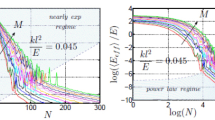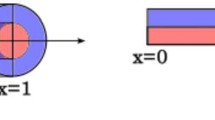Abstract
In previous works we developed a three-dimensional large deformation constitutive theory for a dual cross-link hydrogel gel with permanent and transient bonds. This theory connects the breaking and reforming kinetics of the transient bonds to the nonlinear elasticity of the gel network. We have shown that this theory agrees well with experimental data from both tension and torsion tests. Here we study the mechanics of a Mode III or anti-plane shear crack for this particular class of rate dependent solids. We first show that our constitutive model admits a non-trivial state of anti-plane shear deformation. We then establish a correspondence principle for the special case where the chains in the network obey Gaussian statistics. For this special case there is a one to one analogy between our model and standard linear viscoelasticity. We also study the asymptotic behavior of the time dependent crack tip field, and show that for a wide class of network energy density functions, the spatial singularities of these fields are identical to a hyper-elastic, cracked body with the same but undamaged networks.




Similar content being viewed by others
References
Brown HR (2007) A model of the fracture of double network gels. Macromolecules 40:3815–3818
Chitaley AD, McClintock FA (1971) Elastic-plastic mechanics of steady crack growth under anti-plane shear. J Mech Phys Solids 19:147–163
Cotterell B, Rice JR (1980) Slightly curved or kinked cracks. Int J Fract 16:155–169
Gong JP (2010) Why are double network hydrogels so tough? Soft Matter 6:2583–2590
Gong JP, Katsuyama Y, Kurokawa T, Osada Y (2003) Double-network hydrogels with extremely high mechanical strength. Adv Mater 15:1155–1158
Guo J, Long R, Mayumi K, Hui C-Y (2016) Mechanics of a dual cross-link gel with dynamic bonds: steady state kinetics and large deformation effects. Macromolecules 49:3497–3507
Guo J, Liu M, Zehnder AT, Zhao J, Narita T, Creton C, Hui C-Y (2018) Fracture mechanics of a self-healing hydrogel with covalent and physical crosslinks: a numerical study. J Mech Phys Solids 120:79–95
Henderson KJ, Zhou TC, Otim KJ, Shull KR (2010) Ionically cross-linked triblock copolymer hydrogels with high strength. Macromolecules 43:6193–6201
Hui CY, Riedel H (1981) The asymptotic stress and strain field near the tip of a growing crack under creep conditions. Int J Fract 17:409–425
Ihsan AB, Sun TL, Kurokawa T, Karobi SN, Nakajima T, Nonoyama T, Roy CK, Luo F, Gong JP (2016) Self-healing behaviors of tough polyampholyte hydrogels. Macromolecules 49:4245–4252
Knowles JK (1977) The finite anti-plane shear field near the tip of a crack for a class of incompressible elastic solids. Int J Fract 13:611–639
Kress R (2014) Linear integral equations. Springer, New York
Kuo CK, Ma PX (2001) Ionically crosslinked alginate hydrogels as scaffolds for tissue engineering: part 1. Structure, gelation rate and mechanical properties. Biomaterials 22:511–521
Kwon HJ, Yasuda K, Gong JP, Ohmiya Y (2014) Polyelectrolyte hydrogels for replacement and regeneration of biological tissues. Macromol Res 22:227–235
Lee KY, Mooney DJ (2001) Hydrogels for tissue engineering. Chem Rev 101:1869–1880
Lin W-C, Fan W, Marcellan A, Hourdet D, Creton C (2010) Large strain and fracture properties of poly(dimethylacrylamide)/silica hybrid hydrogels. Macromolecules 43:2554–2563
Long R, Hui C-Y (2015) Crack tip fields in soft elastic solids subjected to large quasi-static deformation—a review. Extreme Mech Lett 4:131–155
Long R, Mayumi K, Creton C, Narita T, Hui C-Y (2014) Time dependent behavior of a dual cross-link self-healing gel: theory and experiments. Macromolecules 47:7243–7250
Long R, Mayumi K, Creton C, Narita T, Hui C-Y (2015) Rheology of a dual crosslink self-healing gel: theory and measurement using parallel-plate torsional rheometry. J Rheol 59:643–665
Mayumi K, Marcellan A, Ducouret G, Creton C, Narita T (2013) Stress–strain relationship of highly stretchable dual cross-link gels: separability of strain and time effect. ACS Macro Lett 2:1065–1068
Mayumi K, Guo J, Narita T, Hui CY, Creton C (2016) Fracture of dual crosslink gels with permanent and transient crosslinks. Extreme Mech Lett 6:52–59
Nakajima T, Kurokawa T, Ahmed S, Wu W, Gong JP (2013) Characterization of internal fracture process of double network hydrogels under uniaxial elongation. Soft Matter 9:1955–1966
Narita T, Mayumi K, Ducouret G, Hébraud P (2013) Viscoelastic properties of poly(vinyl alcohol) hydrogels having permanent and transient cross-links studied by microrheology, classical rheometry, and dynamic light scattering. Macromolecules 46:4174–4183
Qiu Y, Park K (2001) Environment-sensitive hydrogels for drug delivery. Adv Drug Deliv Rev 53:321–339
Rice J (1967) Stresses due to a sharp notch in a work-hardening elastic–plastic material loaded by longitudinal shear. J Appl Mech 34:287–298
Sun J-Y, Zhao X, Illeperuma WRK, Chaudhuri O, Oh KH, Mooney DJ, Vlassak JJ, Suo Z (2012) Highly stretchable and tough hydrogels. Nature 489:133–136
Sun TL, Kurokawa T, Kuroda S, Ihsan AB, Akasaki T, Sato K, Haque MA, Nakajima T, Gong JP (2013) Physical hydrogels composed of polyampholytes demonstrate high toughness and viscoelasticity. Nat Mater 12:932–937
Wang X, Hong W (2011) Pseudo-elasticity of a double network gel. Soft Matter 7:8576–8581
Webber RE, Creton C, Brown HR, Gong JP (2007) Large strain hysteresis and Mullins effect of tough double-network hydrogels. Macromolecules 40:2919–2927
Zehnder AT (2012) Fracture mechanics. Springer, Amsterdam
Acknowledgements
The authors acknowledge support by the National Science Foundation under Grant No. CMMI -1537087.
Author information
Authors and Affiliations
Corresponding author
Additional information
Publisher's Note
Springer Nature remains neutral with regard to jurisdictional claims in published maps and institutional affiliations.
Rights and permissions
About this article
Cite this article
Hui, C.Y., Guo, J., Liu, M. et al. Finite strain theory of a Mode III crack in a rate dependent gel consisting of chemical and physical cross-links. Int J Fract 215, 77–89 (2019). https://doi.org/10.1007/s10704-018-00335-9
Received:
Accepted:
Published:
Issue Date:
DOI: https://doi.org/10.1007/s10704-018-00335-9




